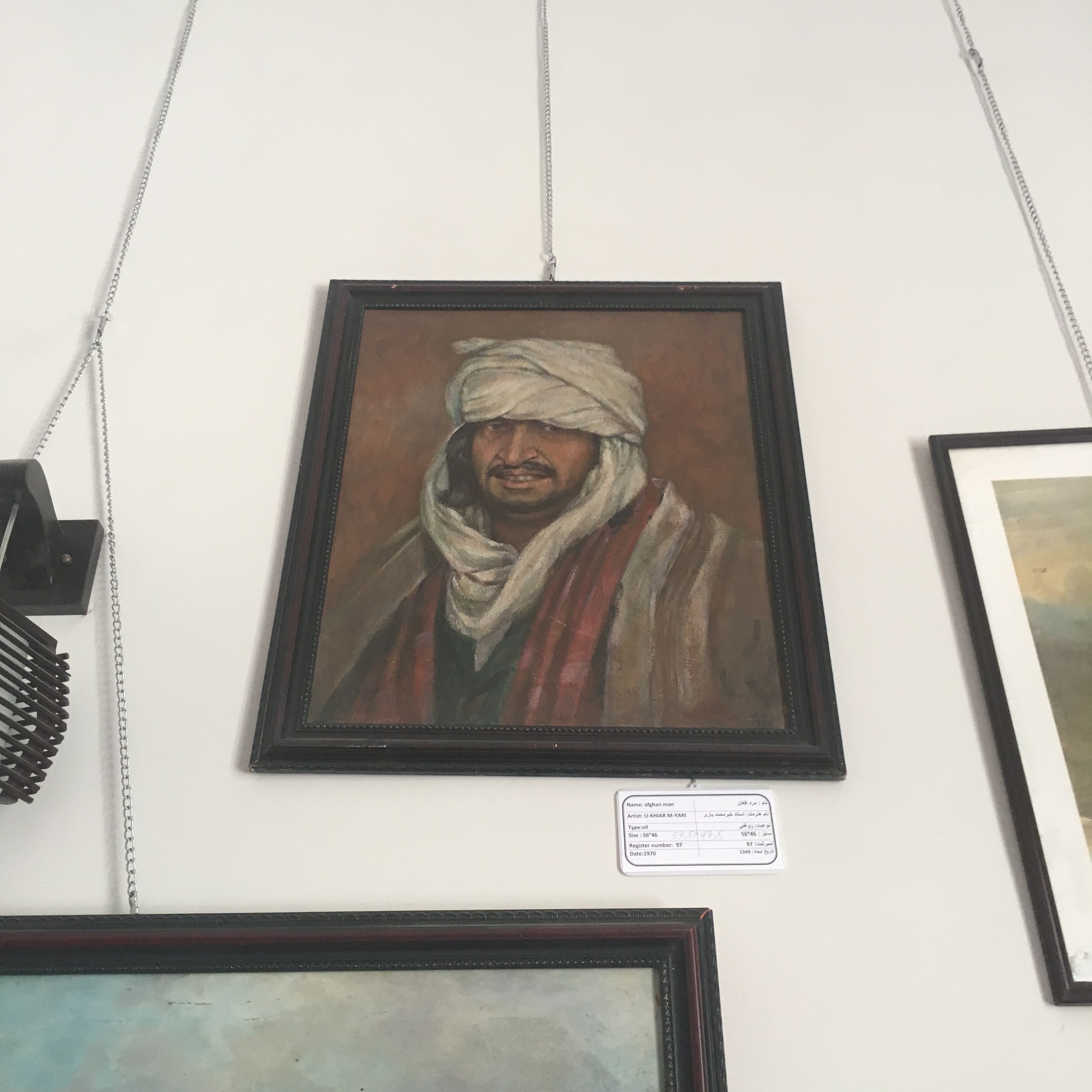/ A long way to go: Afghanistan National Gallery / Muheb Esmat
A long way to go: Afghanistan National Gallery
Muheb Esmat
May 15, 2021

Pictured: Afghanistan National Gallery in Kabul, Image by Michal Hvrockey
In the middle of Kabul's biggest bazaar quarter, locally referred to as Shar (City), sits the Afghanistan National Gallery. Housed in a restored former Royal residence built in the image of 19th-century Europe, a style of architecture favored by the monarchy in the late 19th and early 20th century, the National Gallery opened its doors in May of 1983. Under the Ministry of Information and Culture's auspices, the museum was set up to preserve and exhibit local and international artists' works. Its initial collection of 200 works assembled from the Royal Palace and other museums grew to more than 800 objects by local and foreign artists through a yearly acquisitions program. Unfortunately, this evident growth saw a disturbing end when works from the gallery were looted and destroyed during the Afghan civil war in the early 90’s and the subsequent Taliban regime. The gallery’s recent tumultuous history is tied to the broader calamity suffered by the arts and culture in the country from the ongoing war; which has simultaneously borne incredible stories of resistance to the destructive forces as famously highlighted by the gallery staff painting over figurative works outlawed by the Taliban to save them from destruction.
High on the wall in the middle of a dimly lit hallway hangs an untitled painting by Sayed Maqdos Negah (1937-2000) — a work that had rested as the screen saver for my phone for years prior, yet even more radiant and magnetic in person. With a layer of rubbery black paint constructing its background, the image depicts three musicians marching to the right as they respectively play their Rubab, Tambura, and Sornay. The sharp contours of Negah's figures, bordering between Cubism and outright use of geometric shapes, and the imagined melodies of their instruments tear through the damning silence in the gallery. With no accompanying wall label or biographical information available, a viewer will miss the fact that Negah was not only a painter but also a writer, journalist, and a prominent figure in Kabul's burgeoning theater scene during the ’60s and ’70s. His paintings and marble collages with symmetrically balanced compositions present an exploration of the boundaries of geometric shapes as dynamic expressions able to convey experiences of the physical world through the subtle abstraction of visual metaphors.
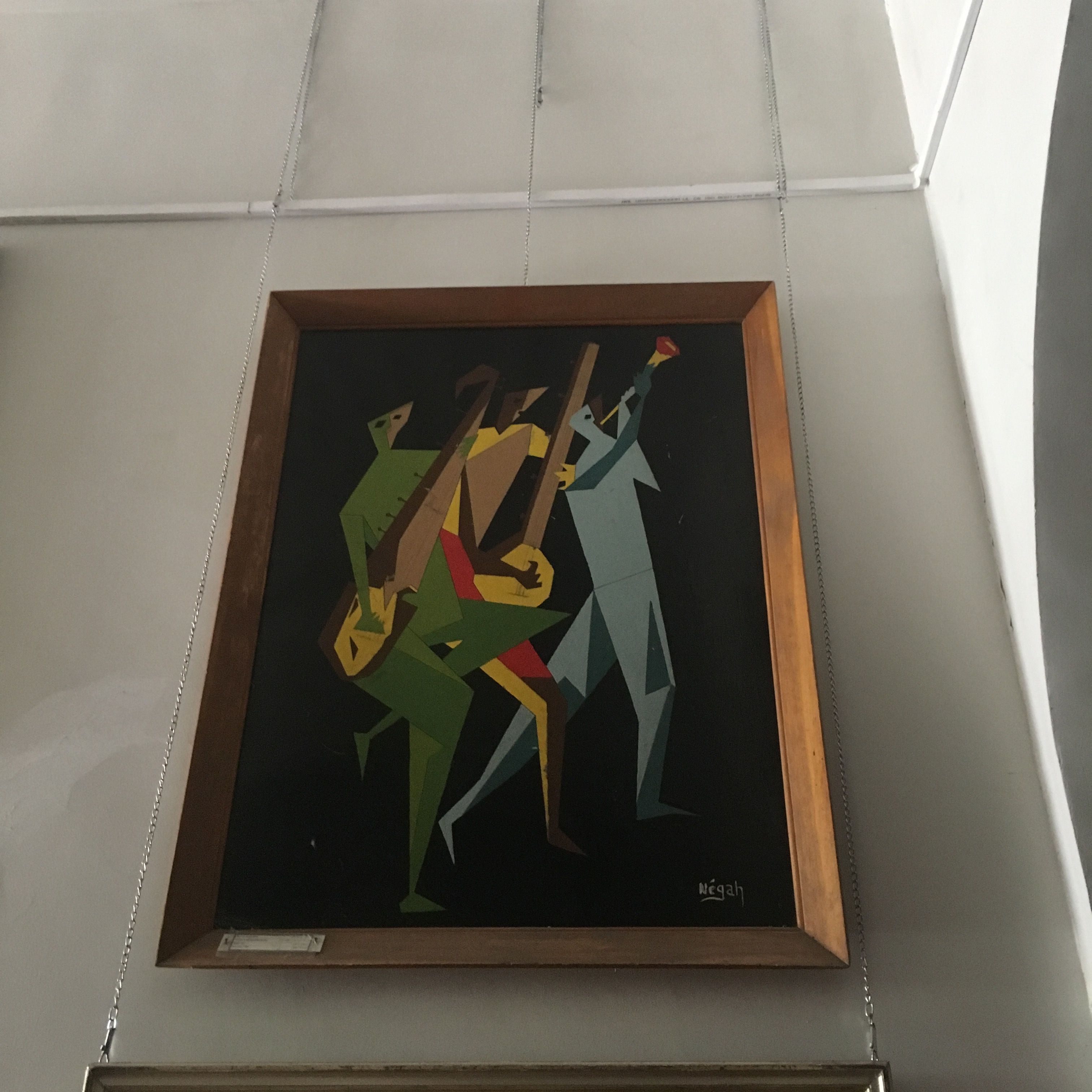
Pictured: Sayed Muqaddos Negah, Untitled, date unknown, oil on canvas.
By utilizing a salon hang, the narrow hallway holds more work than one could imagine, some only identified by the attribute “unknown artist” A stack of prints on paper is left upon a table at the far end of the hallway for visitors to sort through — the kind of informality that feels both groundbreaking in being able to touch the works and concerning when one thinks about these works' long-term preservation. This concern for preservation is further elevated by the lack of temperature control and the fact that most of the galleries are exposed to direct sunlight through the gallery’s windows.
Halfway through the hallway, a red carpet hugging the stairs invites the viewer to the second floor. Several paintings by Master Abdul Aziz sit high on the walls adjacent to the stairs. In an oil on canvas painting, a roaring tiger crawls out of the woods to look directly at the viewer. Aziz, originally from India, was both a court painter and an art teacher in Kabul in the early 20th century. The artist’s presence and influence in Kabul represents a broader history of artists, architects, musicians, and intellectuals from British India visiting and working in Kabul at the time. In the same category as the 'unknown artist' attributions, several works hanging in the second-floor hallway are merely identified as works by "foreigner" artists. A strikingly realistic painting of a seashore, where fierce waves energetically dance towards the shore beneath a soft blue-sky creeping beyond the milky clouds, is hard to miss. Intrigued by the work and the artist's apparent signature, I was able to identify the work to be by a German maritime painter named Patrick Von Kalckreuth (1892-1970). How did Von Kalckreuth's painting end up in Kabul?
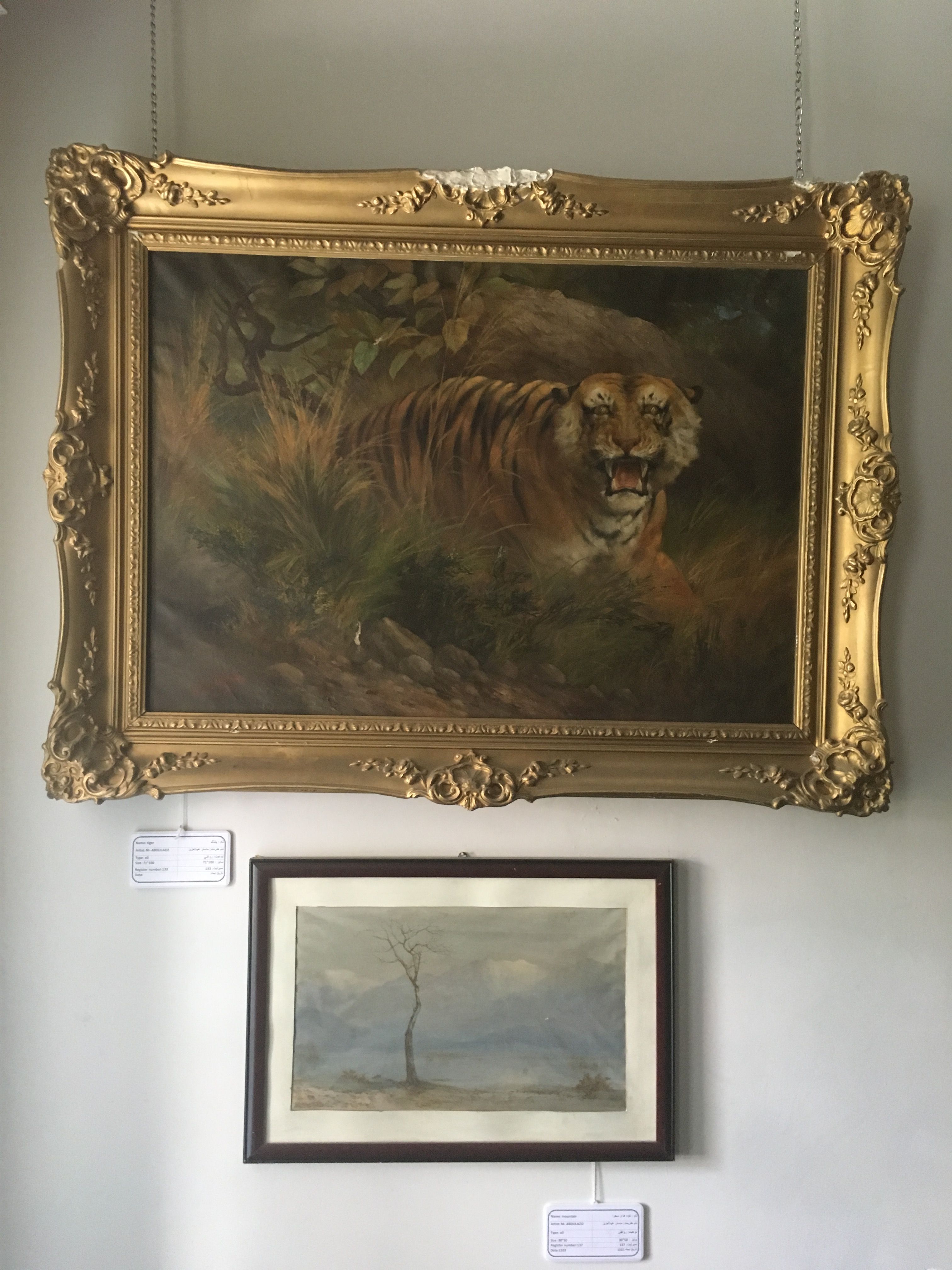
Pictured: Master Abdul Aziz, Tiger, oil on canvas.
Tucked at the right corner beyond a short entrance door are two galleries dedicated to the works of a monumental figure considered by many to be the father of modern Afghan painting, Ghulam Muhammad Maimanagi (1873-1934-5). One of the two distinguished panels installed side by side is labeled as a portrayal of a scene from Europe. This relatively large oil painting depicts a water canal surrounded by lush greenery on the left and an elevated sidewalk on the right, effectively directing the viewer's attention to the row of break houses that then lead to the cathedral building at the center of the painting. A small hole to the upper left corner of the painting, patched with what looks like white paint, represents the extensive evidence of damages, both from light and puncture or decay, found across many of the works currently on display. Aside from his marvelous portrait of Amir Habibullah Khan, most of Maimanagi's works in the gallery portray nature and, more specifically, European landscapes.
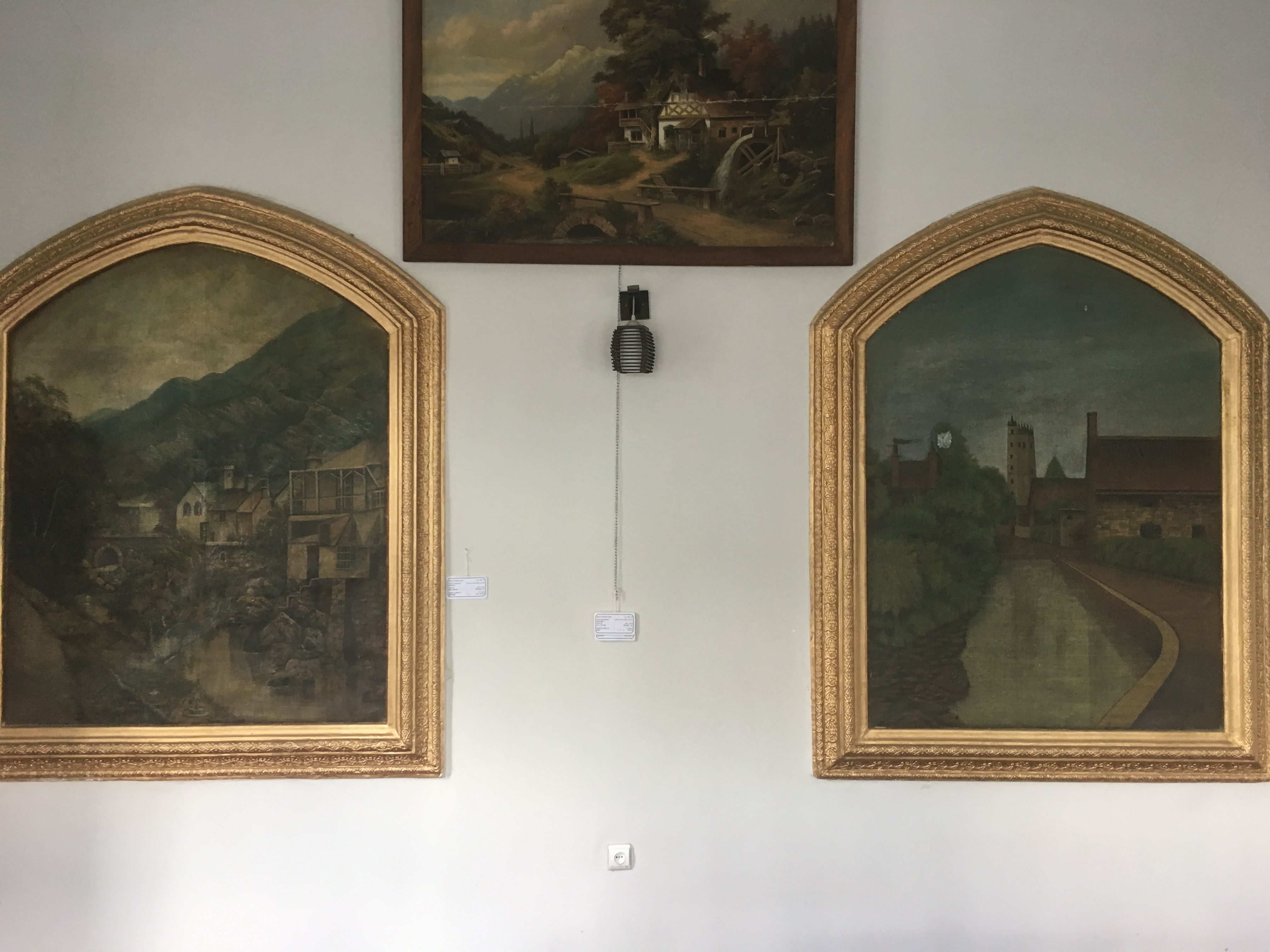
Pictured: Installation view of paintings by Ghulam Muhammad Maimanagi.
In this vein of artists with immense legacies, the adjacent gallery provides a brief glimpse into the works of Abdul Ghafoor Brechna (1907-1974). An oil on canvas painting titled Tabiyat (nature) depicts two young men knee-deep in a watering-hole with their cattle, while a third figure slowly emerges from the shadows of trees perched over a mud wall on the right side. Lurking at the horizon beyond the fields covered in spring green are the beautifully rendered snow-clad peaks. Brechna’s impeccable attention to detail is brilliantly present in the ripples and reflections observed in the water. His painting provides an enchanting contemplation of nature and a timely relic of everyday life outside the urban centers. A recipient of a government scholarship in 1922, Brechna studied painting and lithography in Munich, Leipzig, and Bremen. With his oeuvre stretching beyond the visual arts into music, theater, poetry, and writing, Brechna occupies a unique place as one of the most influential cultural figures of the twentieth century in Afghanistan.

Pictured: Abdul Ghafoor Brechna, Tabiyat,1945, oil on canvas.
A relatively small abstract painting titled Bride and Groom (1960) is of prime importance, partly due to its juxtaposition within the gallery's abundance of realistic images. Thick daubs of oil paint in relatively dark hues give form to a disappearing representation of a wedding scene as remnants of a bride in a white dress and a groom in a black tux march side by side towards the canvas's right corner. This superb painting by Ghaussodin Khan (1910-1995) offers a representation of what paint can achieve with the slight but masterful guidance of a hand like Khan's. Stepping past the short door between the rooms turned into galleries, presented on the wall to the right are watercolor paintings of Kaman-e-bust (or Taq-i bust) in Helmand province, and the Noh Gunbad Mosque located in the northern province of Balkh. In these diligently painted varicolored images, Yosuf Kohzad (1935-2019) gives the viewer a glimpse into the country's cultural heritage and its deteriorated and forgotten state. Kohzad, also a writer, poet, and actor, recently passed away in California, far away from a place he so generously and truthfully depicts in his watercolor paintings exhibited in the gallery.
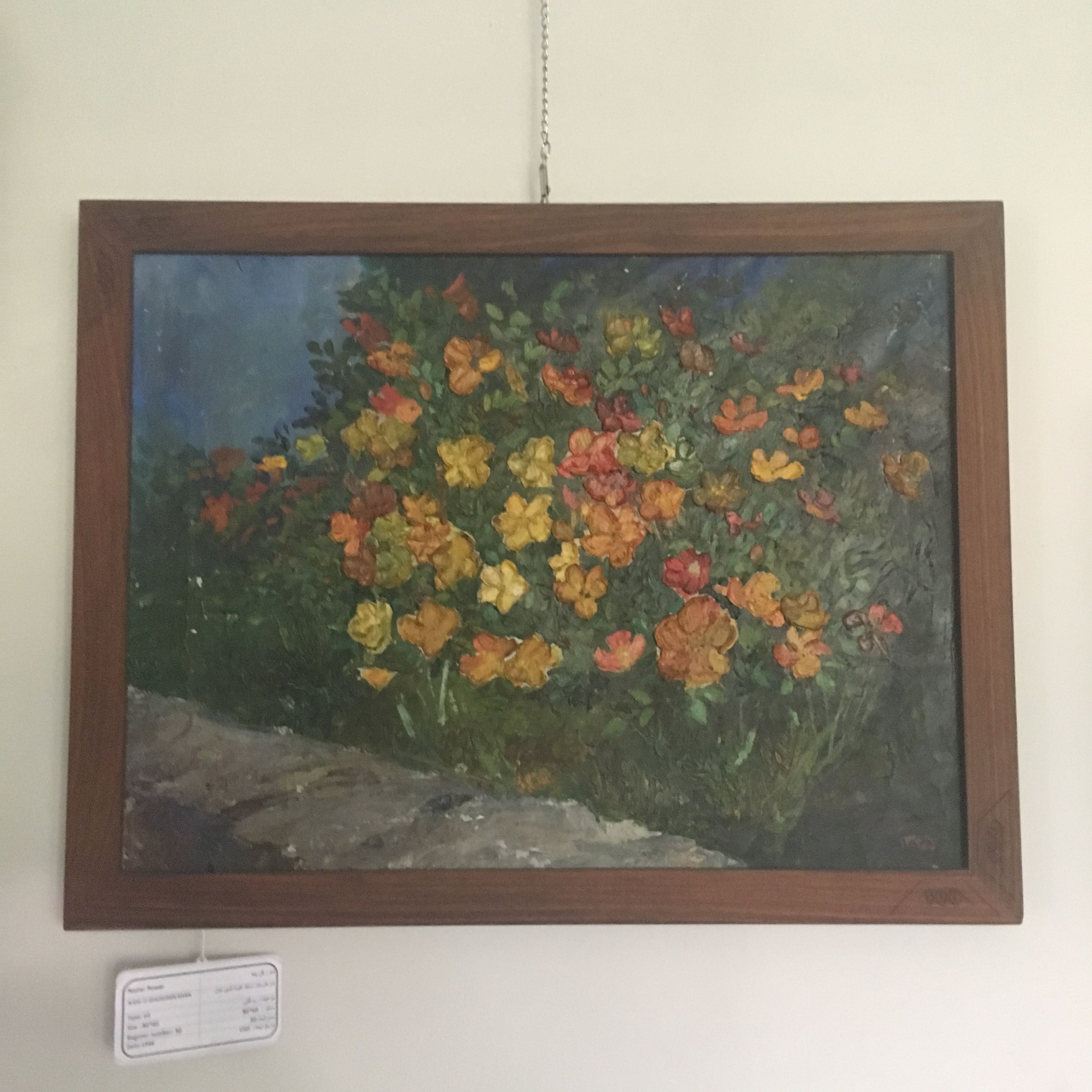
Pictured: Ghaussodin Khan, Flower, oil on canvas, 1946.
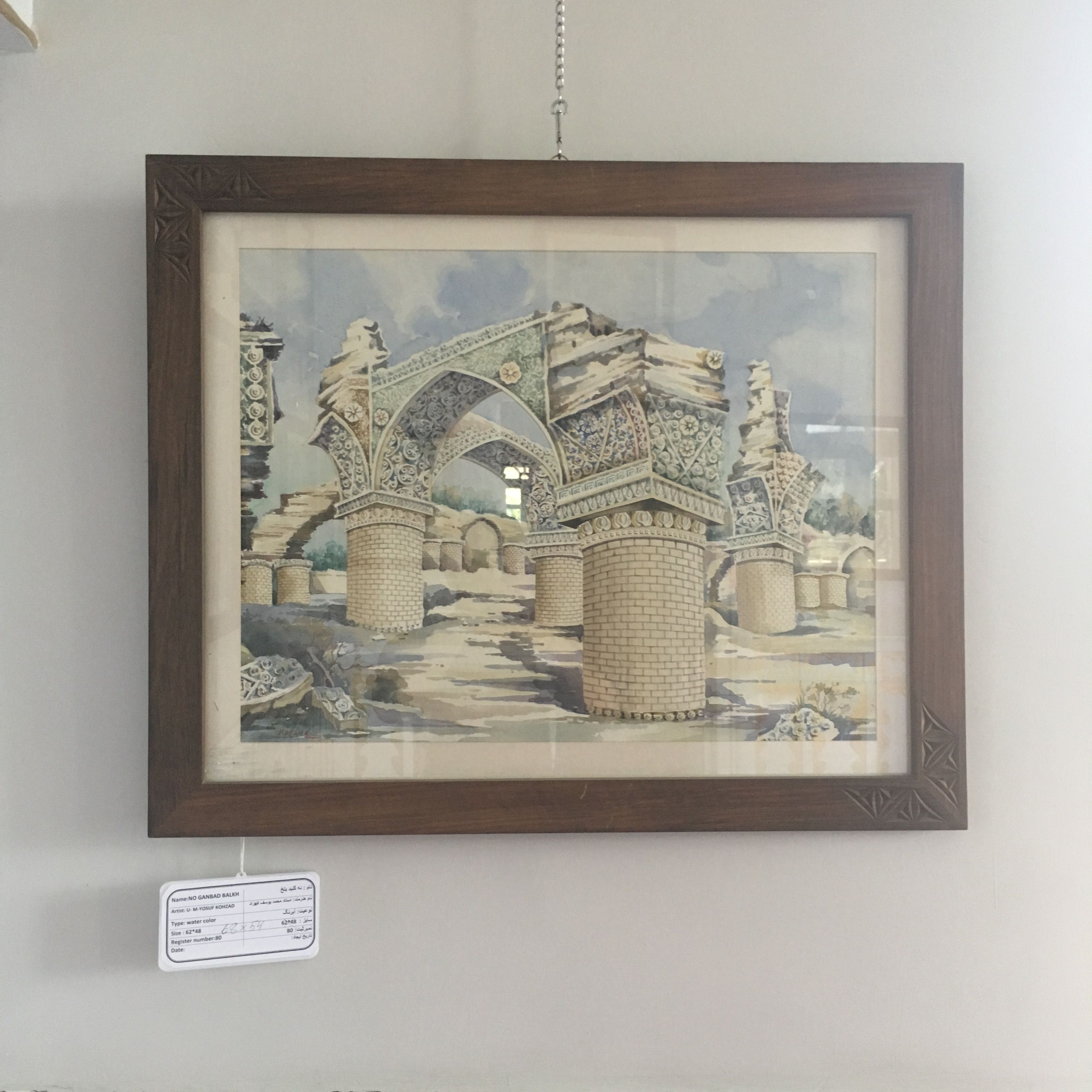
Pictured: Yosuf Kohzad, Noh Gunbad Mosque, watercolor on paper.
Upon entering the final gallery on the second floor, a vertically oriented portrait by Hafizullah Khan Wafa (1985-2006) titled A teacher in Nejat High School(1948) stared back at me with an inscrutable gaze. Wafa depicts a male figure dressed in a pale white shirt, blue tie, and a dark brown jacket that fades into the background. On the adjacent wall, hanging high up, a young man stares down at the viewer with a slight chuckle. A glimpse of his long hair is visible from underneath the fine white turban that sets above his eyes with its tail loosely snaking around his chin with the end tucked in the fold of the turban on the opposite shoulder. The white turban not only frames the subject's face but also elevates through its contrast a peanut brown coat hugging the red scarf dripping down his shoulders, with a brief glimpse of a dark green jacket creeping down the middle of his chest. This oil on canvas painting titled Afghan Man (1970) is by Khair Muhammad Yari (1912-1979). In contrast to Wafa's close focus on his subject's face, Yari’s portraits provide the viewer with an extended image. Together, these intently painted and dramatically striking portraits by Wafa and Yari are only a small example of a less explored history of portraiture painting in the country.

Pictured: Hafizullah Khan Wafa, A teacher at Nejat High School, oil on canvas, 1948.
Stunned by this experience of witnessing this almost anonymous treasure of art and history, as I walked down the stairs on my way out, my eyes caught glimpses of a painting I had missed earlier. Hanging high above a door across from the stairs was a portrait of a male figure dressed in classical European fashion with his right hand resting upon a book placed at the front of the left corner, with a recreation of Eugène Delacroix's Liberty Leading the People (1830) situated behind him. With no information available in the gallery and exhausting the usual research venues, I recently turned to Reddit to crowdsource possible clues. To my surprise, one Reddit user offered a potential lead into the figure's identity that I think is quite plausible. Based on the figure posing with a book, it is likely that they are an author, and knowing that the boy holding a gun up in Delacroix's painting is believed to have been an inspiration of the Gavroche character in Victor Hugo's 1862 novel, Les Misérables, this could be a portrait of Victor Hugo himself. Whether this theory turns out to be true is hard to predict, but what is true is that there are histories to be told about each work in this collection.
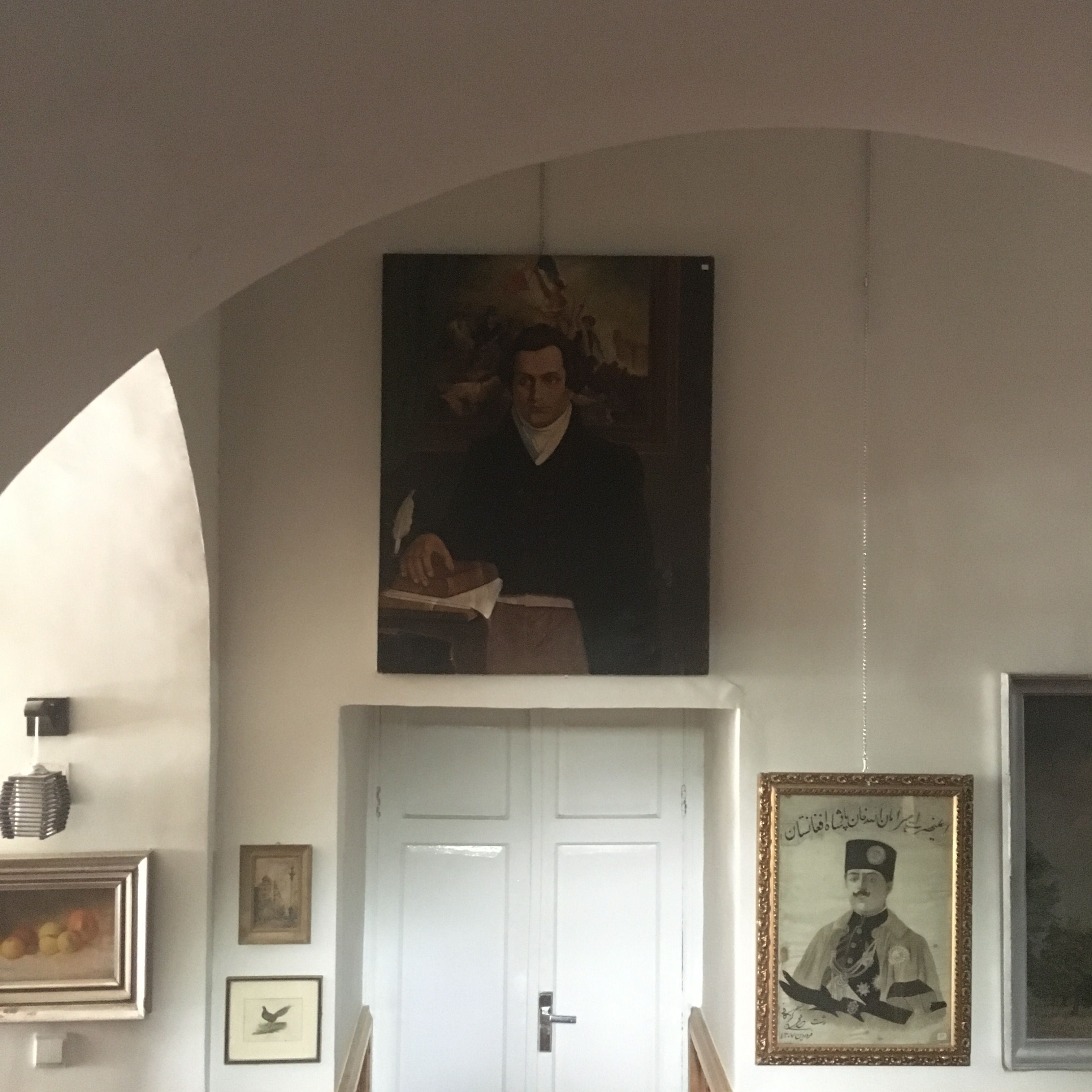
Pictured: A portrait of Victor Hugo by an unidentified artist hanging above the door.
Even though the works on display are treasures worth far longer deliberations, the gallery’s current state leaves a lot to be desired. As the only institution tasked with collecting and preserving modern and contemporary arts in Afghanistan, ANG's collection is overwhelmingly focused on painting, realism, and male artists working in Kabul before the ’90s. Which means that there are not only evident gaps in its collection of 20th-century art from Afghanistan, the institution has also fallen short of keeping pace with the incredible work produced by contemporary Afghan artists. In a way, the fragmented ecosystems that Afghan artists work across is partly due to the institution’s failure in supporting and steering the local art ecosystem and conversation around art and culture in and about the country. With that said, I do believe there are works and histories in the collection that with further research and attention could serve as a stepping stone towards filling a strongly felt gap in the lack of a concise history of 20th-century art in Afghanistan. Although, the inclusivity of any such history will hinge on urgently addressing not only the evident gaps in the collection but also the parameters of its definition of art and culture that is inclusive of the diversity of cultural production in the country.
